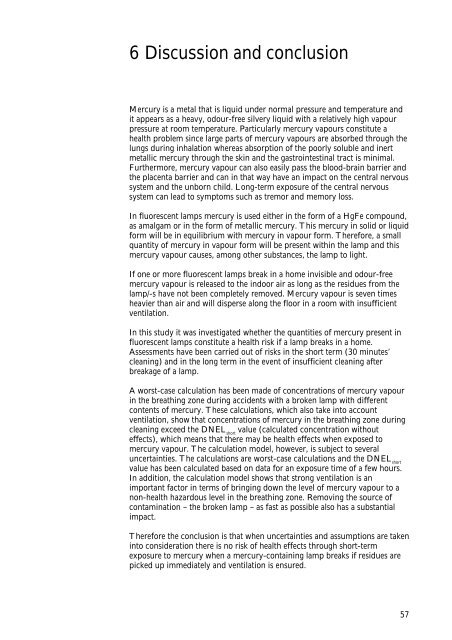No. 104 - Miljøstyrelsen
No. 104 - Miljøstyrelsen
No. 104 - Miljøstyrelsen
You also want an ePaper? Increase the reach of your titles
YUMPU automatically turns print PDFs into web optimized ePapers that Google loves.
6 Discussion and conclusion<br />
Mercury is a metal that is liquid under normal pressure and temperature and<br />
it appears as a heavy, odour-free silvery liquid with a relatively high vapour<br />
pressure at room temperature. Particularly mercury vapours constitute a<br />
health problem since large parts of mercury vapours are absorbed through the<br />
lungs during inhalation whereas absorption of the poorly soluble and inert<br />
metallic mercury through the skin and the gastrointestinal tract is minimal.<br />
Furthermore, mercury vapour can also easily pass the blood-brain barrier and<br />
the placenta barrier and can in that way have an impact on the central nervous<br />
system and the unborn child. Long-term exposure of the central nervous<br />
system can lead to symptoms such as tremor and memory loss.<br />
In fluorescent lamps mercury is used either in the form of a HgFe compound,<br />
as amalgam or in the form of metallic mercury. This mercury in solid or liquid<br />
form will be in equilibrium with mercury in vapour form. Therefore, a small<br />
quantity of mercury in vapour form will be present within the lamp and this<br />
mercury vapour causes, among other substances, the lamp to light.<br />
If one or more fluorescent lamps break in a home invisible and odour-free<br />
mercury vapour is released to the indoor air as long as the residues from the<br />
lamp/-s have not been completely removed. Mercury vapour is seven times<br />
heavier than air and will disperse along the floor in a room with insufficient<br />
ventilation.<br />
In this study it was investigated whether the quantities of mercury present in<br />
fluorescent lamps constitute a health risk if a lamp breaks in a home.<br />
Assessments have been carried out of risks in the short term (30 minutes’<br />
cleaning) and in the long term in the event of insufficient cleaning after<br />
breakage of a lamp.<br />
A worst-case calculation has been made of concentrations of mercury vapour<br />
in the breathing zone during accidents with a broken lamp with different<br />
contents of mercury. These calculations, which also take into account<br />
ventilation, show that concentrations of mercury in the breathing zone during<br />
cleaning exceed the DNEL short value (calculated concentration without<br />
effects), which means that there may be health effects when exposed to<br />
mercury vapour. The calculation model, however, is subject to several<br />
uncertainties. The calculations are worst-case calculations and the DNEL short<br />
value has been calculated based on data for an exposure time of a few hours.<br />
In addition, the calculation model shows that strong ventilation is an<br />
important factor in terms of bringing down the level of mercury vapour to a<br />
non-health hazardous level in the breathing zone. Removing the source of<br />
contamination – the broken lamp – as fast as possible also has a substantial<br />
impact.<br />
Therefore the conclusion is that when uncertainties and assumptions are taken<br />
into consideration there is no risk of health effects through short-term<br />
exposure to mercury when a mercury-containing lamp breaks if residues are<br />
picked up immediately and ventilation is ensured.<br />
57

















